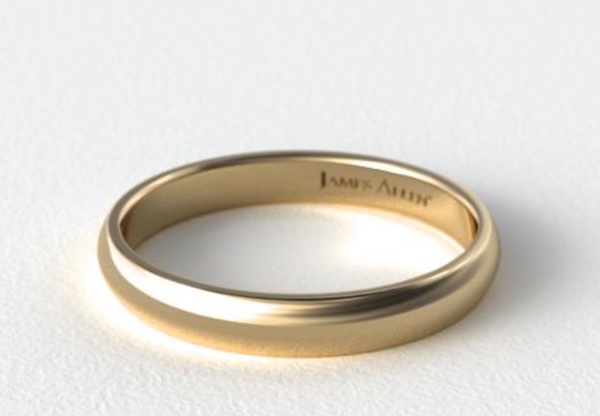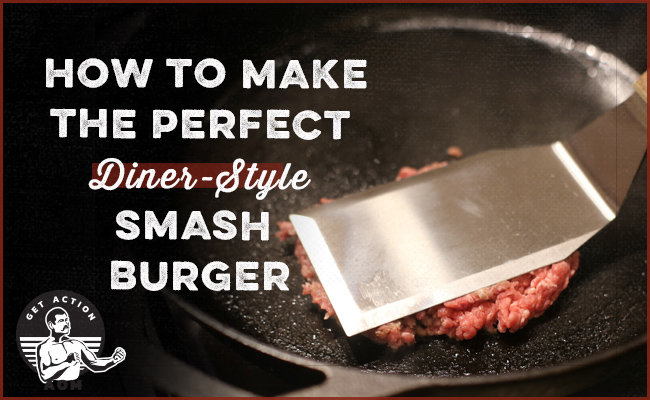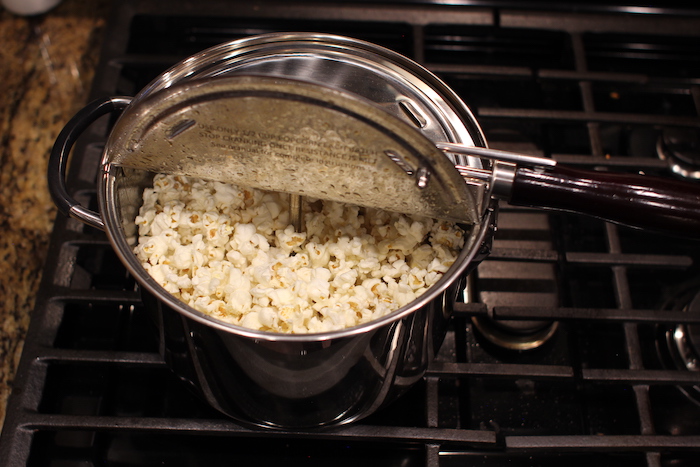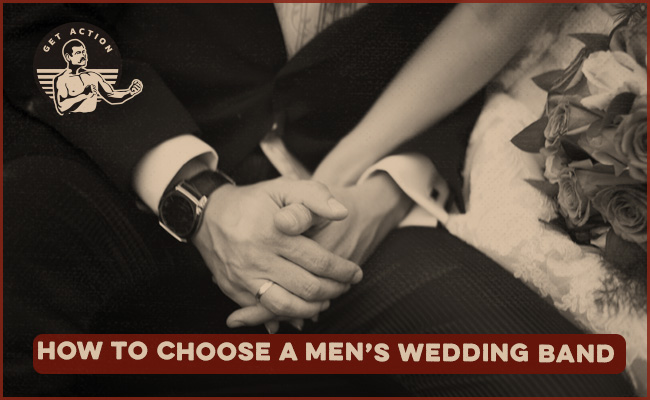
When it comes to wedding rings, much of the focus inevitably ends up on the fiancee’s engagement ring. Come wedding time, the bands for both bride and groom end up as more of an afterthought. A couple decades ago, there simply wasn’t much variety in men’s rings. The options basically came down to a simple band of gold or silver with, perhaps, a decorative flourish or gem. That was about it.
Recent years have seen an explosion of options for men hit the marketplace, which means you have more to think about — in a good way! The looks and materials available for men’s rings have never been more stylish, frankly. With that, of course, comes plenty of chintzy options made with bizarro materials and/or very niche/unique designs. To help guide you grooms-to-be through the options and selection process, below we go over everything you need to know to pick the perfect men’s wedding band.
Big thanks to the guys at Manly Bands for providing some info and pictures. This is NOT a sponsored article; I simply relied on their expertise in figuring out the types of things a man should consider when choosing a ring.
To Match or Not to Match?
The first question you’ll need to consider in choosing a wedding band is whether you and your soon-to-be spouse want to have matching rings or not. Traditionally, the bands of man and wife did match, as they were a symbol of their unity and partnership. But that tradition has very much loosened up today, and the choice of whether to have matching or distinct bands is entirely up to you. Matching bands continue to offer a potent symbol of oneness, but getting distinct bands allows each partner to choose something that speaks to their own personal style.
If you like the idea of coordinated rings, but don’t want to choose identical bands, consider getting rings that are different and yet complementary — being made of the same material or with the same gem, used in different ways. Or engrave the same saying on the inside of each band.
Your Personal Style
When it comes to your wedding ring, what’s most important is simply your personal style. There are no options that are necessarily better or worse; you just have to browse and decide what sort of thing you genuinely like.
Beware of going with a design or material that seems really cool at first blush, but may end up feeling gimmicky in a decade or two. Sure, you may love baseball, but do you really want a ring that has red baseball stitches engraved on it, for the rest of your life? You need to think about your future self too.
That said, men’s rings are a little different from women’s engagement rings and you can certainly trade out later if your personal style changes (as mine has in my 10 years of being married). More on that below in the “Budget” section.
Though some guys may shrug off the ring choice — “Oh, I don’t care, just get me whatever” — I encourage you to put some thought and time into it. Get something that you’ll be truly happy to wear for the rest of your life.
Material
When it comes to wedding rings for men, there’s quite a lot of variety in material and color options. Beyond just your classic precious metals (gold, silver, platinum) there are also modern metals like tungsten and titanium, as well as more unique materials like wood, meteorite, and even antler/dinosaur bone. Rings made with silicone are also growing in popularity. Let’s look at each of these materials, first considering whether you want a diamond or gem of some sort.
Diamonds/Gems

In this option, the diamond is surrounded by rose gold, with a meteorite inlay.
One of the first questions to consider when it comes to materials is if you’ll want a diamond or gem of some sort incorporated into the ring. In a woman’s diamond engagement ring, the gem is often set above the ring itself; the point is for the diamond to be the star of the show. In men’s rings, diamonds are set within the ring itself as more of a complement to the overall look rather than the focal point. Diamonds (and other gems) obviously boost the price quite a bit, but it can be a really sharp and classy look if you have the budget for it. That said, diamonds can feel a little too flashy for most grooms, and are certainly still in the minority when it comes to men’s wedding rings.
Precious Metals
Gold (yellow, white, rose). The most traditional option and almost certainly what your dad and granddad have/had. Can be resized more easily than other materials since it’s a “soft” metal; that also means it scratches somewhat easily, however. Price generally remains pretty high unless it’s utilizing gold plating or is a lower carat.
Silver. The other classic option for wedding ring material, though it’s not as common anymore. As with gold, it’s a softer material that will wear and show its age after a decade or two. It’s cheaper than other precious metals. Most of the silver-colored rings you’ll find on the market today are actually made of white gold or a hard metal (see below).
Platinum. Platinum is the most expensive of the classic metals, but is super durable — a platinum ring will likely last and look the same your whole life. Platinum also has a nice natural shine.
Modern Metals
These materials are getting the “modern” moniker not because the materials are actually modern, but because their use in wedding rings is. These all have similar looks and are often paired with inlays of other materials like carbon fiber, turquoise, a precious metal, etc.
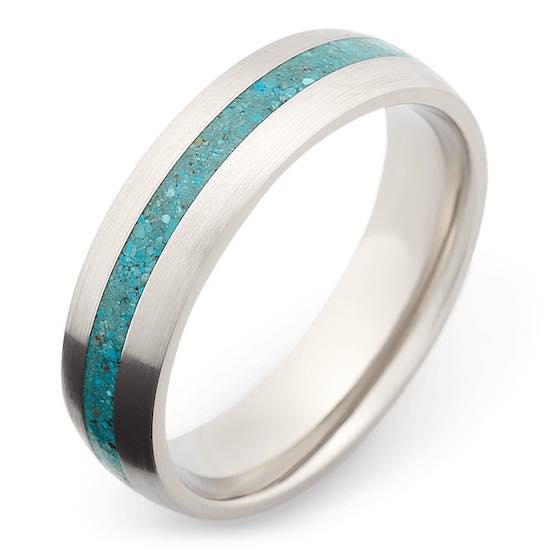
A titanium ring with a turquoise inlay.
Titanium. The hardest natural metal available, which also means it’s hard to resize. It’s mostly scratch-resistant (though not entirely) and quite lightweight. More affordable than the above precious metals.
Tungsten. The hardest, most durable material for rings. This man-made metal is silver in color (though it can be mixed with other materials to make other colors) and pretty much unbreakable. That also makes it nearly impossible to resize. It’s denser than the other metals here, making it just a touch heavier — which isn’t necessarily a bad thing, the ring will just feel more noticeable on your finger.
A few other metals you’ll find include cobalt, steel, and tantalum. When considering these metals, it’s really just a matter of your style and your budget — all of them are durable and, on their own (that is, without inlays or gems), pretty affordable.
Unique Materials
There is a growing range of more unique materials that don’t fall into the metals category:
Ceramic. Though it’s basically clay, it’s super-hardened and nearly as durable as the hard metals described above. Ceramic retains its initial luster longer than other materials and is quite affordable. It also has a more unique look and comes in more color options. Again, though, it’s difficult to resize and can shatter with an especially hard impact.
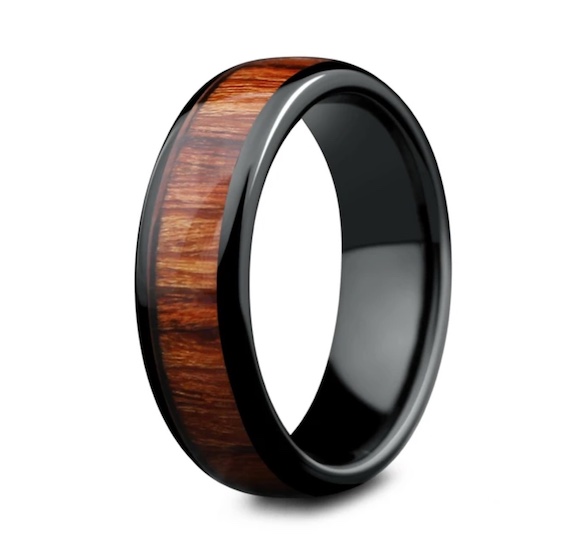
A ring with a wooden inlay flanked by sturdy ceramic on the sides.
Wood. It might seem strange to go with a wooden wedding ring. Won’t it break down? Be more susceptible to the elements (including sweat)? Well, in fact, most wooden rings aren’t typically made entirely of wood (though 100% wood rings do exist); instead, just the inlay is made of wood, and this inlay is then protected by more durable materials, like the metals listed above, on the outside or interior of the ring. A ring with a wooden inlay offers unique variations with colors and patterns, and ages with more of a noticeable patina than metal. It may also chip/scratch a little easier, especially if it’s an all-wood ring. That said, a wood ring is still very durable, just less so than one made entirely of hard metal.
Meteorite/Antler/Bone. When you find a material that seems a little gimmicky, it will almost always be reinforced by metal (as with the wood). In my opinion these materials tend to just drive the price up (though not always) and they don’t necessarily offer a totally unique look (you might know you’re wearing a dinosaur bone on your finger, but no one else is likely to realize that). But, if you’re super into space and you want a meteorite on your finger, you can sure as shoot do that.
Silicone rings, like this one, come in a wide variety of colors, patterns, and textures.
Silicone. This rubber-like material is quickly becoming a more popular choice for wedding rings, particularly as a “back-up” ring for when you’re adventuring, working with machinery, lifting weights, on vacation, or in any scenario where a more expensive, traditional ring could get lost, damaged, or be a target for theft. But some gents do choose a silicone ring to be their primary wedding band. It may not feel as nice or meaningful, but some guys like that it represents their more laid-back, unostentatious approach to life.
Silicone rings are incredibly affordable (as in, under $50!), replaceable, comfortable, and becoming more and more stylish with each passing year as the market grows. Basic options abound, but there are some companies, like Enso, which fuse silicone with a little bit of metal to make a better looking and more unique ring (while still coming in at under $50).
Ring Width
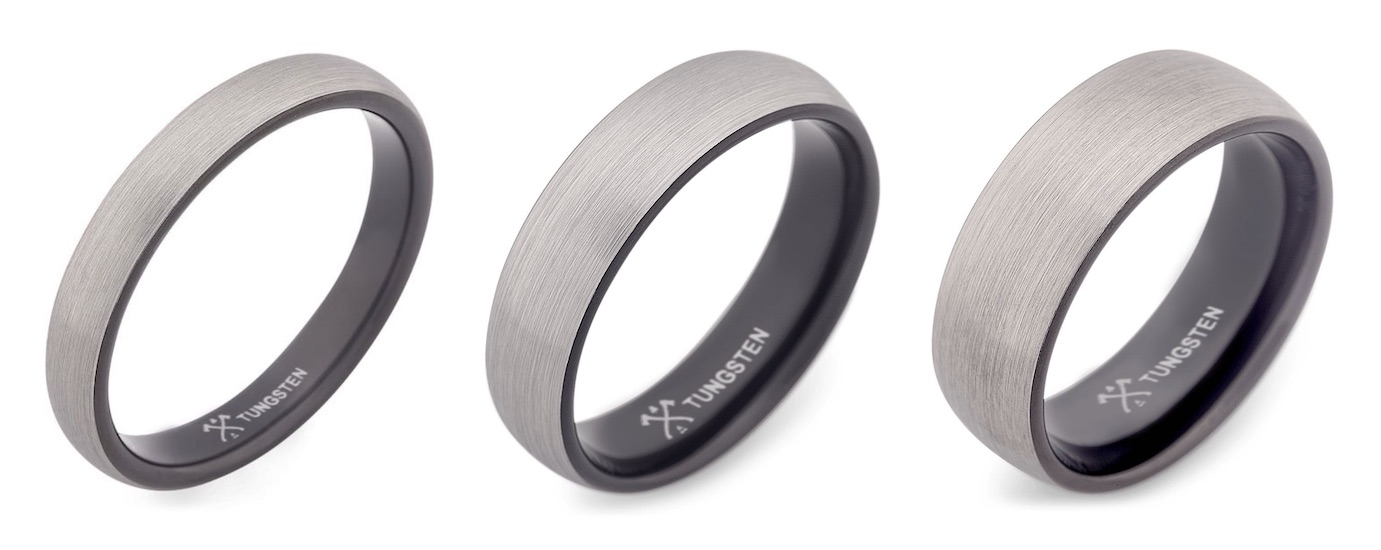
The same ring at 4 mm, 6 mm, and 8 mm wide.
The width of your wedding ring is likely to make a bigger difference in its overall look and feel than you’d think. Most rings will be between 4 mm and 8 mm wide, though outliers on either end do exist. Many men gravitate towards the upper end of that range; 4 mm and below tends to look a little dainty (though not always), whereas an 8 mm ring just looks more bold and durable.
When thinking about how wide to get your ring, the first thing to take into account is your own hand and finger size. If you have small-ish hands, an 8 mm band might be too big and stick out a little too much. I have small-to-average hands and wore an 8 mm ring for a long time before trying on a 6 mm ring — the latter looks a lot better and more proportional on my finger. On the flip side, a small 4 mm ring looks rather out of place on a man with meaty hands and fingers.
The other main factor when it comes to ring width, as with all these other categories, is your personal style. A wider ring is a bolder choice and inherently a little more noticeable. A thinner ring is more understated and naturally blends in a bit better rather than standing out.
Fit/Size
There are two options for how the ring fits on your finger — standard and comfort. Standard, as you can imagine, is how every ring used to fit and simply means that the inside of the ring, the part that comes in contact with your finger, is totally flat. Standard fit is a little harder to get on and off over the knuckle and may slide around on the finger a little more.
The vast majority of rings these days are comfort fit. This means that the inside of the ring is slightly domed, which makes it more comfortable, easier to get on and off, and ensures the ring stays put a little better.
Sizing up your finger for a ring is pretty easy these days. Most companies, especially here in the age of COVID, offer to send you a free or very cheap ring sizing guide, which is basically just a keychain of different ring sizes for you to try on. There are also apps that’ll do the trick.
Budget
While the average engagement + wedding ring combo for a woman is well over $6,000 (yowza!), the average wedding ring for guys comes in at about $500. But, you can find options well above and well below that number. If you have the money and desire, you can easily spend $2,000-$3,000 — and higher — with a combination of unique materials, inlays, and/or gems. On the flip side, there are a lot of really nice, durable, stylish rings that will come in at around $200 or even less.
The big question, really, is how to determine a ring budget in the first place. Those rules about monthly salaries have always been bunkum — in fact, the 2-3 month’s salary rule was created by De Beers because they wanted guys to spend more money on engagement rings. Unfortunately, there’s no real formula. You have to look at your current financial situation, determine what you (and your fiancee) are comfortable with, and go from there. While a diamond engagement ring may be forever, in the world of men’s rings, it’s pretty darn easy to trade up after a handful of years (or a decade or two) if your first ring was budget-friendly (though you may become sentimentally attached to the rings you exchanged at the altar).
You’re now equipped to make an informed choice on the ring that, hopefully, you’ll be wearing ‘til death do you part — and not even then, since you’re likely to be buried with it!


